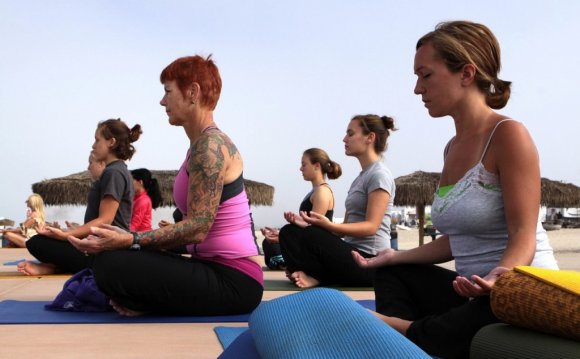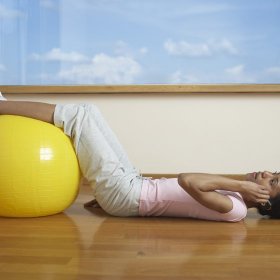

Related Articles
A bridge is a beginner level exercise that targets muscles in your abs, butt and hips. Without any extra equipment, you can tone nearly a dozen muscles with this one basic move. When you do a standard bridge exercise, you primarily target your rectus abdominis and your gluteus maximus. If you want to increase the challenge, add in a stability ball.
Primary Muscles
Your rectus abdominis runs from your pubic bone up to your fifth, sixth and seventh rib. When you think of six-pack abs, you are imagining this muscle. It engages when your flex or rotate your trunk. Your gluteus maximus is one of three muscles that make up your glutes. It is your largest glute muscle and is responsible for the shape of your buttock. It starts in your pelvis, stretches diagonally over your buttock and connects to your femur. It engages when you straighten your hip, rotate your leg or move your leg towards your body.
Secondary Muscles
During a bridge, you recruit nearly half a dozen muscles to act as stabilizers. Your erector spinae, which runs along your spine, engages to straighten your spine. Your transverse abdominis, which functions as a corset around your abdomen, engages to stabilize your core. Your gluteus medius and minimus, the other two muscles in your gluteus, steady your pelvis so it doesn’t sag. Your hamstrings, which run along the back of your thighs, engage to bend your knees and straighten your hips. Your hip adductors, which run from your pelvis to your femur, assist with bending and straightening your hip.
Proper Form
To ensure you engage all these muscles correctly, perform the glute bridge with proper form. Begin by lying on the floor face up. Bend your knees and place your feet flat on the floor about 8 to 10 inches away from your buttock. Engage your abs, exhale and lift your hips toward the ceiling. Press your heels into the floor for added stability. Lift until you create a straight line from your shoulders to your knees. Avoid letting your back arch too much. Gradually lower to the starting position and repeat.
Making it Harder
If you want to engage even more muscles and challenge your body further, grab a stability ball. By doing the bridge on a stability ball, you primarily target your erector spinae, rectus abdominis, transverse abdominis, gluteus maximus and obliques. Stabilizing muscles include your gluteus minimus and medius, quadriceps, hamstrings and adductors. To do this move correctly, lie on the floor face up with your feet resting on the top of the ball. They should be a few inches apart and your ankles should be slightly flexed. Engage your core and lift your hips off the floor. Your heels will press into the ball. Lift until you create a straight line from your shoulders to your ankles. Gradually lower to the starting position and repeat.









